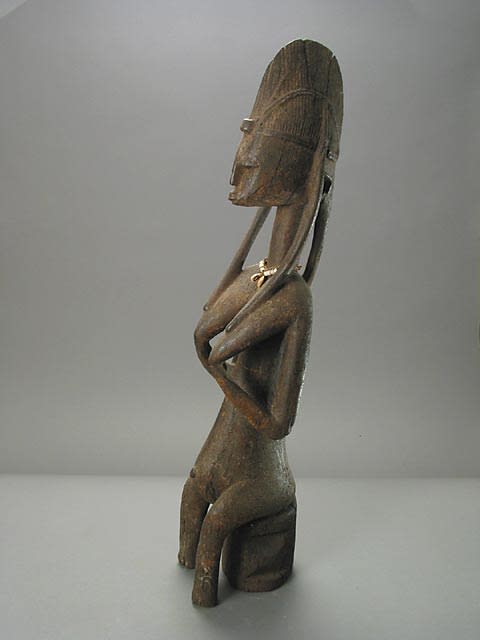Bambara Wooden Guannyeni Sculpture of a Standing Woman, 20th Century CE
Wood
32.25
PF.6124 (LSO)
Further images
This elegant figure of a woman was made by the Bamana (or Bambara) of Mali. It represents a woman truncated at the knees and seated in a low seat. The...
This elegant figure of a woman was made by the Bamana (or Bambara) of Mali. It represents a woman truncated at the knees and seated in a low seat. The body is sinuous and curvaceous, the hands supporting the pendulous breasts. The neck is tall and columnar, supporting a crested coiffure that extends down onto the chest on both sides. The wood is dark and irregularly patinated. The neck is adorned with a short necklace of white trade beads.
The Bambara/Bamana is one of the largest groups in Mali (about 2.5 million) and lives in a savannah grassland area that contrasts strongly with the Dogon heartland. Their linguistic heritage indicates that they are part of the Mande group, although their origins go back perhaps as far as 1500 BC. The Mande-speaking Songhai empire dissolved in the 1600s, and many Mande speakers spread out along the Nigeria River Basin. The Bamana empire arose from these remnant populations in around 1740, and reached its imperial maximum in the 1780s under the rule of N’golo Diarra.
Their society is Mande-like overall, with patrilineal descent and a nobility/vassal caste system. Their complex history is echoed in the systematics of indigenous art traditions. There are four main mask forms, related to various secret societies. Other forms include the famous Chi-Wara headcrest, which was used to encourage good harvests, and heavily encrusted zoomorphic ‘Boli’ figures. Everyday items include iron staffs, door-locks, wooden puppets and equestrian figures, which double as accessories for male initiation ceremonies.
The Guan society is responsible for the maintenance and use of Guandousou (queen) and Guantigui (king) statues. Two of these figures are surrounded by five of these forms, which are typically designed to represent the ideal values of femininity, specifically fertility. The pieces were stored in shrines and exhibited annually.
This is a striking piece of African art.
The Bambara/Bamana is one of the largest groups in Mali (about 2.5 million) and lives in a savannah grassland area that contrasts strongly with the Dogon heartland. Their linguistic heritage indicates that they are part of the Mande group, although their origins go back perhaps as far as 1500 BC. The Mande-speaking Songhai empire dissolved in the 1600s, and many Mande speakers spread out along the Nigeria River Basin. The Bamana empire arose from these remnant populations in around 1740, and reached its imperial maximum in the 1780s under the rule of N’golo Diarra.
Their society is Mande-like overall, with patrilineal descent and a nobility/vassal caste system. Their complex history is echoed in the systematics of indigenous art traditions. There are four main mask forms, related to various secret societies. Other forms include the famous Chi-Wara headcrest, which was used to encourage good harvests, and heavily encrusted zoomorphic ‘Boli’ figures. Everyday items include iron staffs, door-locks, wooden puppets and equestrian figures, which double as accessories for male initiation ceremonies.
The Guan society is responsible for the maintenance and use of Guandousou (queen) and Guantigui (king) statues. Two of these figures are surrounded by five of these forms, which are typically designed to represent the ideal values of femininity, specifically fertility. The pieces were stored in shrines and exhibited annually.
This is a striking piece of African art.





